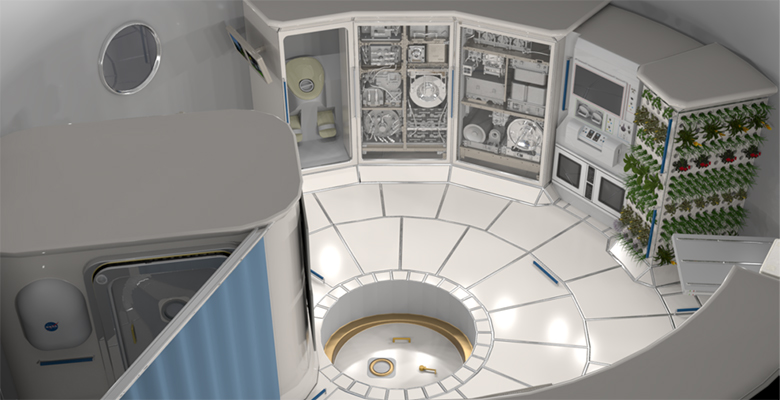
Illustration of the interior of a deep space habitat. Photo courtesy: NASA
(April 10, 2019) -- UTSA has been tapped by The National Aeronautics and Space Administration (NASA) to join a team that will build homes for human habitation on the moon and Mars. As exploration missions beyond Earth become more ambitious, NASA must consider new technologies to keep habitats operational when they are not occupied by astronauts.
To help achieve this, NASA has selected UTSA to be part of its Space Technology Research Institutes (STRIs) to advance space smart habitat designs, or SmartHab. This research will complement other NASA projects to help mature the mission architecture needed to meet challenging exploration goals.

Arturo Montoya, associate professor with dual appointments in the UTSA Department of Civil Engineering and Mechanical Engineering, will be part of NASA’s Resilient ExtraTerrestrial Habitats institute (RETHi).
UTSA, led by Arturo Montoya, an associate professor with dual appointments in the Department of Civil Engineering and Mechanical Engineering, will join NASA’s Resilient ExtraTerrestrial Habitats institute (RETHi). The RETHi seeks to design and operate resilient deep space habitats that can adapt, absorb and rapidly recover from expected and unexpected disruptions. It plans to leverage expertise in civil infrastructure with advanced technology fields such as modular and autonomous robotics and hybrid simulation.
As part of the RETHi program, UTSA will receive financial support to build computational models including the algorithms needed to build resilient moon and Mars future homes.
“This grant will allow UTSA, and its students, to play a key role in solving the challenge of deep space habitation, while building partnerships with NASA facilities, universities and industries,” said Montoya.
Through an integrated effort, RETHi will mature deep space habitats that can operate in both crewed and un-crewed configurations. The institute plans to create a cyber-physical prototype testbed of physical and virtual models to develop, deploy and validate different capabilities. The RETHI team includes Purdue University, the University of Connecticut, and Harvard.
“Our participation in efforts to map a reality of extraterrestrial habitation as part of this initiative helps to support President Eighmy’s vision for UTSA as a great multicultural discovery enterprise and being world-engaged,” said UTSA’s JoAnn Browning, dean of the College of Engineering. “This grant also illustrates our emphasis on multi-disciplinary research, as it brings together the fields of autonomous robotics, advanced computing methods for hybrid simulation, and sustainable civil infrastructure design.”
In addition to RETHI, NASA will also fund a second institute: Habitats Optimized for Missions of Exploration (HOME). HOME’s design approach for deep space habitats relies on proven engineering and risk analysis and on emergent technologies to enable resilient, autonomous and self-maintained habitats for human explorers.
UTSA with the other collaborators will be funded by NASA’s Space Technology Mission Directorate, which is responsible for developing the cross-cutting, pioneering, new technologies and capabilities needed by the agency to achieve its current and future missions. As one of the top research universities in the country, UTSA along with the new institutes could receive as much as $15 million over a five-year period.
Learn more about Professor’s Montoya work.
Learn more about NASA’s STRIs programs.
Celebrate UTSA’s 50th Anniversary and share social media posts about the 50th using the hashtag #UTSA50.
Connect with UTSA online at Facebook, Twitter, YouTube, Instagram and LinkedIn.
UTSA Today is produced by University Communications and Marketing, the official news source of The University of Texas at San Antonio. Send your feedback to news@utsa.edu. Keep up-to-date on UTSA news by visiting UTSA Today. Connect with UTSA online at Facebook, Twitter, Youtube and Instagram.
Enjoy snacks while connecting with Adobe reps and student ambassadors. Download or log into the Adobe Express app to snag swag and unlock exclusive back-to-school templates. It’s a fun, fast way to get creative and start the school year with bold moves.
Central Plaza, Main CampusCelebrate the merger of UTSA and UT Health San Antonio with a pop-up featuring free t-shirts, exclusive swag, and interactive photo opportunities. Open to all students, faculty and staff. Supplies are limited!
Sombrilla Plaza, Main CampusHuddle Against Hunger is a fundraising competition with Texas State that benefits our Roadrunner Pantry. Donations this week will help UTSA earn additional prize monies provided by RBFCU.
In-Person and VirtualJoin UTSA Libraries for an update on federal public access policies and how the library can assist with compliance.
Virtual EventWe invite you to join us for Birds Up! Downtown, an exciting welcome back event designed to connect students with the different departments at the Downtown Campus. Students will have the opportunity to learn about some of the departments on campus, gain access to different resources, and collect some giveaways!
Bill Miller PlazaThere are many citation managers. Which one is right for you? This workshop will explain what a citation manager is and how it can help you organize your citations, insert citations as you write your paper, and generate your bibliography.
Virtual EventPubMed is an essential database for anyone conducting biomedical or health-related research. This workshop will teach attendees how to effectively navigate this free resource and locate peer-reviewed articles using advanced search features, MeSH subject headings, and Boolean operators.
Virtual EventThe University of Texas at San Antonio is dedicated to the advancement of knowledge through research and discovery, teaching and learning, community engagement and public service. As an institution of access and excellence, UTSA embraces multicultural traditions and serves as a center for intellectual and creative resources as well as a catalyst for socioeconomic development and the commercialization of intellectual property - for Texas, the nation and the world.
To be a premier public research university, providing access to educational excellence and preparing citizen leaders for the global environment.
We encourage an environment of dialogue and discovery, where integrity, excellence, respect, collaboration and innovation are fostered.